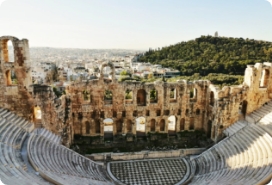Cythera
The Island, also named Kythira, has been occupied since the Helladic period, contemporary with the Minoans. There are archaeological evidence of Kythiran trade as far as Egypt and Mesopotamia. During the Early Archaic age, the Island was occupied by a Phoenician settlement, mentioned by ancient sources. Later on, during classical times, Kythira was part of the territory of several larger city-states. Sparta took the island from Argos early in the 6th century BC. In Thucydides’ time Athens occupied it three times in the course of the Peloponnesian wars. Kythira became independent and minted its own coins in 195 BC. In Augustus’ time, it was again subject to Sparta, being the property of Gaius Julius Eurycles, who was both a Spartan magnate and a Roman citizen. Kythira continued to be occupied under the Roman rule and during the Byzantine.
Chronology of studies
Pottery
This section proposes documentation related to ancient pottery and ceramics. This kind of material was one of most common class of artifacts in ancient times and many everyday objects were made of ceramic. Perfume container, fine table ware, crude commercial packing and maritime containers, are different examples of the artifacts presented here.
Data sheets
Coins
Numismatic material is always an interesting source of information. Each mint was a way for a state authority to show its power, as much as a tool for mercantile and day to day transactions. As such, coins distribution do not directly offer evidence of contact, as money always change hands, but some coins series, like bronze minting, are more a proof of travels and possible relationship.
Data sheets
Epigraphy
Texts and writing are clear evidence of the presence of a Phoenician and Punic individual or community: one express and interacts in its language and writings. As such, the presence of Phoenician epigraphy always tells us that an individual from Tyre, Sidon or Carthage was author of the text, or at least mandatory. Bilingual text, in our case translated from Greek or from Phoenician, are evidently even more interesting as they show the existence of a multicultural environment.
Data sheets
Glass
Glass production was distinctly in the beginning a craft originating from the ancient near east, Egypt and the Levant having access then to the sole raw material sources. Phoenician craftsman became expert in producing small containers and jewels, artifacts which rarity made them seen as luxury goods. As time was passing, more and more workshop learnt to use the raw material, but the Phoenician, and their descendants in the western Mediterranean, were expert in this craftsmanship all along the 1rst millennium B.C.
Data sheets
Other material
Many ancient objects could be connected with the Phoenician and Punic population, whether it is stone made of raw material from the Levant, or metal artifacts which raw material sources were directly controlled by the Phoenician, thanks to their control and tin and silver sources of the western Mediterranean. This section consider all the different material evidence which show us the diversity of the contacts between the Hellenic populations of the Aegean and Phoenician and Punic communities.
Data sheets
Pottery
This section proposes documentation related to ancient pottery and ceramics. This kind of material was one of most common class of artifacts in ancient times and many everyday objects were made of ceramic. Perfume container, fine table ware, crude commercial packing and maritime containers, are different examples of the artifacts presented here.
Data sheets
Coins
Numismatic material is always an interesting source of information. Each mint was a way for a state authority to show its power, as much as a tool for mercantile and day to day transactions. As such, coins distribution do not directly offer evidence of contact, as money always change hands, but some coins series, like bronze minting, are more a proof of travels and possible relationship.
Data sheets
Epigraphy
Texts and writing are clear evidence of the presence of a Phoenician and Punic individual or community: one express and interacts in its language and writings. As such, the presence of Phoenician epigraphy always tells us that an individual from Tyre, Sidon or Carthage was author of the text, or at least mandatory. Bilingual text, in our case translated from Greek or from Phoenician, are evidently even more interesting as they show the existence of a multicultural environment.
Data sheets
Glass
Glass production was distinctly in the beginning a craft originating from the ancient near east, Egypt and the Levant having access then to the sole raw material sources. Phoenician craftsman became expert in producing small containers and jewels, artifacts which rarity made them seen as luxury goods. As time was passing, more and more workshop learnt to use the raw material, but the Phoenician, and their descendants in the western Mediterranean, were expert in this craftsmanship all along the 1rst millennium B.C.
Data sheets
Other material
Many ancient objects could be connected with the Phoenician and Punic population, whether it is stone made of raw material from the Levant, or metal artifacts which raw material sources were directly controlled by the Phoenician, thanks to their control and tin and silver sources of the western Mediterranean. This section consider all the different material evidence which show us the diversity of the contacts between the Hellenic populations of the Aegean and Phoenician and Punic communities.



